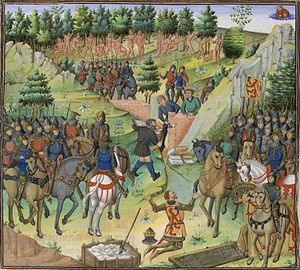Our website is made possible by displaying online advertisements to our visitors.
Please consider supporting us by disabling your ad blocker.
Gog and Magog

Gog and Magog (/ˈɡɒɡ ... ˈmeɪɡɒɡ/; Hebrew: גּוֹג וּמָגוֹג, romanized: Gōg ū-Māgōg) or Ya'juj and Ma'juj (Arabic: يَأْجُوجُ وَمَأْجُوجُ, romanized: Yaʾjūju wa-Maʾjūju) are a pair of names that appear in the Bible and the Qur'an, variously ascribed to individuals, tribes, or lands. In Ezekiel 38, Gog is an individual and Magog is his land.[1] By the time of the New Testament's Revelation 20 (Revelation 20:8), Jewish tradition had long since changed Ezekiel's "Gog from Magog" into "Gog and Magog".[2]
The Gog prophecy is meant to be fulfilled at the approach of what is called the "end of days", but not necessarily the end of the world. Jewish eschatology viewed Gog and Magog as enemies to be defeated by the Messiah, which would usher in the age of the Messiah. One view within Christianity is more starkly apocalyptic, making Gog and Magog allies of Satan against God at the end of the millennium, as described in the Book of Revelation.[3]
A legend was attached to Gog and Magog by the time of the Roman period, that the Gates of Alexander were erected by Alexander the Great to repel the tribe. Romanized Jewish historian Josephus knew them as the nation descended from Magog the Japhetite, as in Genesis, and explained them to be the Scythians. In the hands of Early Christian writers they became apocalyptic hordes. Throughout the Middle Ages, they were variously identified as the Vikings, Huns, Khazars, Mongols or other nomads, or even the Ten Lost Tribes of Israel.
The legend of Gog and Magog and the gates were also interpolated into the Alexander Romances. According to one interpretation, "Goth and Magothy" are the kings of the Unclean Nations whom Alexander drove through a mountain pass and prevented from crossing his new wall. Gog and Magog are said to engage in human cannibalism in the romances and derived literature. They have also been depicted on Medieval cosmological maps, or mappae mundi, sometimes alongside Alexander's wall.
The conflation of Gog and Magog with the legend of Alexander and the Iron Gates was disseminated throughout the Near East in the early centuries of the Christian and Islamic era.[4] They appear in the Quran in chapter Al-Kahf as Yajuj and Majuj, primitive and immoral tribes that were separated and barriered off by Dhu al-Qarnayn ("He of the Two Horns") who is mentioned in the Quran as a great righteous ruler and conqueror.[5] Some contemporary Muslim historians and geographers regarded the Vikings as the emergence of Gog and Magog.[6]
- ^ Lust 1999b, pp. 373–374.
- ^ Cite error: The named reference
boringwas invoked but never defined (see the help page). - ^ Cite error: The named reference
mouncewas invoked but never defined (see the help page). - ^ Bietenholz 1994, p. 123.
- ^ Van Donzel & Schmidt 2010, pp. 57, fn 3.
- ^ Sawyer, P. H. (10 April 1982). Kings and Vikings: Scandinavia and Europe, A.D. 700–1100. Methuen. ISBN 9780416741902 – via Google Books.
Previous Page Next Page


